Michigan
| |
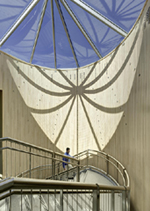 |
Ann Arbor |
Michigan |
USA |
Cylindrical Dial |
Dial 1085 |
| The dial is inscribed on a 20-ft (6m) diameter stairwell creating a very large cylindrical altitude sundial. The nodus is the center of the skylight directly above the circular stair well. Hours are marked at the top of the dial in Arabic numerals. Hour lines are a series of dots extending down the wall. A display near the dial explains how it functions. |
| |
| |
 |
Ann Arbor |
Michigan |
USA |
Vertical Dial |
Dial 618 |
| A painted steel on building brick vertical dial with a 6 foot gnomon. Gnomon includes decoration of two children and a gear wheel. Hour markings are Roman numerals. |
| |
| |
 |
Ann Arbor |
Michigan |
USA |
Equatorial Dial |
Dial 617 |
| A three foot wide brass and steel armillary of complex design with many features. Gift of Albina du Bolsrouvray. Markings are in French. |
| |
| |
 |
Ann Arbor |
Michigan |
USA |
Vertical Dial |
Dial 199 |
| A stone and bronze vertical dial approximately 10x6 feet just below the roof of the Mack School. Dial face includes Roman numerals showing Eastern Standard Time and a polar gnomon. Inscription appears below gnomon. |
| |
| |
 |
Ann Arbor |
Michigan |
USA |
Horizontal Dial |
Dial 616 |
| A 6 foot (1.8m) square weathering steel horizontal dial with a 3 foot (1m) high and 6 inch (15cm) wide steel gnomon in the shape of a simple triangle. Hour lines are welded steel strips, but without hour numerals. The dial is set on a steel wedge such that on sloping ground it brings the dial face horizontal. The noon gap is an artistically designed angular strip. The hour lines are offset from local, reflecting the 26 min advance from the central time zone meridian. Local mean noon (when the mean gnomon shadow falls in the noon gap) occurs at 12:26pm CST. A Plaque with the Equation of Time to convert shadow time into CST is being developed. |
| |
| |
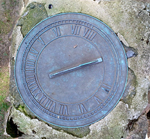 |
Ann Arbor |
Michigan |
USA |
Horizontal Dial |
Dial 1087 |
| This horizontal brass dial is 16-inch (40.6cm) in diameter. A chapter ring holds hours marks in Roman numerals from 4am to 8pm, and includes 10 minute marks at the outer edge of the ring. The dial is plain with no inscription. The gnomon is broken off at the face of the dial. The dial is a placed on an irregular stone mount with two concrete blocks with the name Chubb and Sessions, whose family graves surround the sundial memorial. |
| |
| |
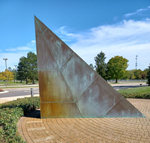 |
Ann Arbor |
Michigan |
USA |
Horizontal Dial |
Dial 1084 |
| This is a large monumental scale horizontal sundial. The gnomon, approximately 15-ft (4.5m) high has a brass patina and made using polygonal segments assembled almost in jigsaw puzzle style to form a large triangle. The gnomon sits at the north end of a large 30-ft (9.1m) brick plaza, wasting the area of the plaza except for a large imbedded brass plaque. Hours are simply marked by light colored granite with a pointed exterior aimed toward the edge of the plaza. Harder to see are half-hour light colored small granite triangles. |
| |
| |
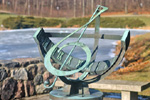 |
Ann Arbor |
Michigan |
USA |
Equatorial Dial |
Dial 335 |
| Large equatorial dial, with gnomon in the shape of a treble clef sign. Approximately 4 foot across. Dedicated to founders of Sigma Alpha Iota international music fraternity for women. Dial sits atop a tapered cylinder 3 ft high. |
| |
| |
 |
Ann Arbor |
Michigan |
USA |
Noon Mark or Meridian Dial |
Dial 1096 |
| Dial is a calendar dial that marks noon on the solstices and equinoxes by projecting a circle of sunlight onto one of three horizontal discs on the meridian line dial face. To create the round sunlight spots the vertical arm has three elliptical holes to match the solar angles for the two solstices and the equinox. The disk closest to the gnomon (with highest solar angle) is for the summer solstice. Middle disk is for the equinoxes, and the farthest disk (with lowest solar angle) is for the winter solstice. Notice in the photo that the summer hole in the vertical arm is considerably stretched to account for the high angle of the sun. |
| |
| |
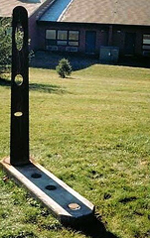 |
Ann Arbor |
Michigan |
USA |
Noon Mark or Meridian Dial |
Dial 1088 |
| Dial is a calendar dial that marks noon on the solstices and equinoxes by projecting a circle of sunlight onto one of three horizontal discs on the meridian line dial face. To create the round sunlight spots the vertical arm has three elliptical holes to match the solar angles for the two solstices and the equinox. The disk closest to the gnomon (with highest solar angle) is for the summer solstice. Middle disk is for the equinoxes, and the farthest disk (with lowest solar angle) is for the winter solstice. Notice in the photo that the summer hole in the vertical arm is considerably stretched to account for the high angle of the sun. |
| |
| |
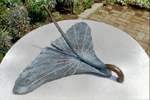 |
Bloomfield Hills |
Michigan |
USA |
Horizontal Dial |
Dial 837 |
| In Cranbrook Gardens, where works of art topiary and American crafts are displayed, one can find a brass horizontal dial transformed into a beautiful sculpture of a ginkgo leaf with the stem serving as the style. Hour lines are the radiating leaf veins. A small circle with Arabic numbers delineates each hour from 6am to 6pm..The ginkgo leaf sundial is about 40 cm and the height of the tail about 14 cm. The sundial hour circle is about 20 cm in diameter. |
| |
| |
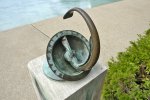 |
Bloomfield Hills |
Michigan |
USA |
Equatorial Dial |
Dial 770 |
| An equatorial dial of cast bronze. The heavily patinated dial has Roman hour numerals IIII through VIII and a cast bronze pointer marked, "DAYLIGHT SAVING." It has an unusual crescent shaped arm with notch at the upper end. The arm is rotated until sunlight passes through a hole in the upper arm and strikes an analemma with monthly dates on the lower inner curve of the crescent. Time is then read on a circular dial from an "hour hand" pointer extending from the base of the crescent. The dial sits atop a marble pedestal engraved: "The A.N. Goddard Sundial" |
| |
| |
 |
Brooklyn |
Michigan |
USA |
Horizontal Dial |
Dial 311 |
| A well-rusted horizontal dial of iron or steel about 10 inches diameter on a stone and masonry pedestal. Dial face shows Arabic hour numerals but hour line angles may be wrong. Mounted atop a stone and masonry pedestal. |
| |
| |
 |
Detroit |
Michigan |
USA |
Armillary Sphere |
Dial 88 |
| A 6 foot diameter wrought iron armillary with equatorial and polar rings. Hour numerals are missing. Cast zodiacal signs are present in fair condition on exterior of equatorial ring. Dial is on a decaying brick circular pedestal at the center of a concrete and brick base. Rings are heavily marked with graffiti. The dial sits atop a brick and mortar pedestal in poor condition. |
| |
| |
 |
East Lansing |
Michigan |
USA |
Analemmatic Dial |
Dial 384 |
| This garden analemmatic dial uses plants to mark time with plants selected to demonstrate bio-rhythms by their daily opening and closing at different times. Four-o'clocks are planted at the 4 block. Magic evening primroses 'Tina James' encircle the area. Flowers open in 15 seconds to the sunlight, quite a spectacular sight! Also planted here are: Evening Primroses, Portulaca 'Sundial', Coreopsis 'Sunray', Morning Glory, Thyme, Four-O'clock, and Moonvine.
Children cast their shadow to tell the time. Step between the blocks of the current month, raise your right hand, and your shadow tells the time. The analemmatic dial is set up for daylight saving time. |
| |
| |
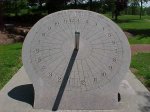 |
Frankenmuth |
Michigan |
USA |
Equatorial Dial |
Dial 194 |
| This monument sundial is an Erickson equatorial polar dial 6 feet in diameter made of light granite with a 3 inch steel rod as gnomon. Time is graduated by hour, half-hour, quarter hours and 5 minute marks over 24 hours. Noon is at the bottom, matching the 105 degree meridian. Designed to be read from the upper surface in Spring/Summer, from the under side in Fall/Winter. Unlike other Erickson dials, the Equation of Time plaque is presented in a circular arc on the ground. |
| |
| |
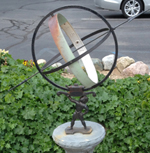 |
Frankenmuth |
Michigan |
USA |
Armillary Sphere |
Dial 896 |
| This is a mass produced armillary dial held at the latitude of Frankenmuth by the statute of a boy with raised arm. All this sits on a pedestal with a Greek motif. The meridian circle made of iron is about 2 feet in diameter. The equatorial band is about 3 inches wide with some corrosion present. Inside the equatorial there appears to be an aluminum interior band of Arabic numbers riveted to the equatorial. Hours and half hours are marked by dot bumps in the aluminum. There is an iron latitude ring for decoration. The bronze gnomon extends the meridian circle with both an arrow point and feathered tail. |
| |
| |
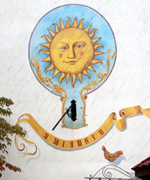 |
Frankenmuth |
Michigan |
USA |
Vertical Dial |
Dial 897 |
| The dial is elegantly painted on the south wall declining 30 deg west. Dial shows daylight savings time using dark red Roman numerals on a golden ribbon banner. The gnomon is a simple rod held firmly to the wall by an ornate bracket. Above the dial is a large smiling sun surrounded by a sky blue band. |
| |
| |
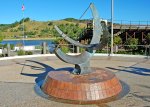 |
Grand Haven |
Michigan |
USA |
Equatorial Dial |
Dial 601 |
| A bronze equatorial dial approximately 6 feet high with bowstring gnomon. Hour markings show Daylight Saving Time and are longitude corrected. Dial sits atop a brick plinth. |
| |
| |
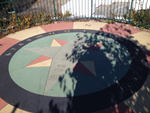 |
Grand Rapids |
Michigan |
USA |
Analemmatic Dial |
Dial 892 |
| The brightly colored analemmatic dial is approx 10.5 feet in diameter, surrounded by a ring of alternating red and white concrete with cardinal points. Time marks are set in a ring of black concrete, with large engraved hour numbers. Time is adjusted for daylight saving time.[Note that to tell time correctly, the time marks should be set on an ellipse.] The walkway for standing to cast your shadow has monthly names impressed into the concrete. |
| |
| |
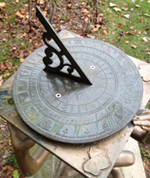 |
Grand Rapids |
Michigan |
USA |
Horizontal Dial |
Dial 287 |
| A cast iron statue of a small boy painted in gold and kneeling. With arms upright, he holds a plate on top of his head that held the original sundial face, surrounded by an inscription and ornamentation. The statue is bolted to a concrete pedestal. With the original sundial gnomon removed, a new oversized horizontal dial has been carelessly bolted onto the top plate. The gnomon and dial face imply it is a British reproduction, totally unsuited for the Michigan location. The dial face is ornate, with a compass rose in the center, surrounded by a chapter ring divided in 15 minute intervals. A second, outer chapter ring divides time into 5 minute intervals. Time is indicated with Roman numeral hour marks. Dial in good alignment, but illuminated by the sun only during early morning. |
| |
| |
 |
Holt |
Michigan |
USA |
Equatorial Dial |
Dial 646 |
| A four foot high equatorial dial possibly of painted cast aluminum on a four foot high segmented granite pedestal. Hour ring displays Roman numerals for EST with five minute marks with longitude correction. Tiles of pedestal bear names and birth/death dates of those memorialized. |
| |
| |
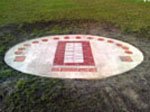 |
Howell |
Michigan |
USA |
Analemmatic Dial |
Dial 788 |
| A 16 by 20 foot, two-tone concrete analemmatic dial with 7 AM to 8 PM Arabic hour numerals on 12 inch round stamped concrete disks. Instructional and use information is shown on impressed lettering colored concrete plates. |
| |
| |
|
Kalamazoo |
Michigan |
USA |
Horizontal Dial |
Dial 96 |
| Large circular bench ca 25' in diameter forms ring with hour markings. Aluminum or stainless steel gnomon. Relatively new. |
| |
| |
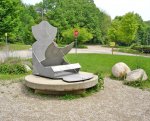 |
Kalamazoo |
Michigan |
USA |
Compound Dial |
Dial 733 |
| A combination horizontal, vertical, polar and equatorial dial 4 x 5 x 6 foot tall made of drilled aluminum plate with rod gnomon. The vertical plate shows the EOT graph and depiction of Earth showing polar tilt, celestial equator and Earth equator using drilled holes. The bottom plate below the equatorial face includes a compass rose that also shows the direction of sunrise and sunset at the solstices. All dial faces are marked using Arabic numerals with hour and 15 minute marks.
The Kalamazoo Nature Center is open most days and charges an admission fee. |
| |
| |
 |
Kalamazoo |
Michigan |
USA |
Analemmatic Dial |
Dial 430 |
| A modernistic analemmatic dial. The ellipse is a raised stone wall with large Arabic numbers for each hour from 5am to 7 pm. The concrete patio in front of the wall contains the analemmatic line of months as an indicator of where to stand for casting the shadow. |
| |
| |
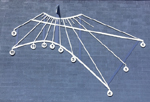 |
Lansing |
Michigan |
USA |
Vertical Dial |
Dial 923 |
| This is a vertical, east-declining sundial, 22 ft 6 in by 15 ft 10 in. The dial is constructed of 6061 aluminum alloy pieces electrostatically painted and bolted together,then mounted on a concrete block wall. The position of the gnomon, hour, solstice, and equinoctial lines are corrected for longitude to show time zone solar time. Stenciled hour line numbers are changed to display DST or EST at appropriate times of the year. Visitors can determine the correct time by referring to an Equation of Time display. During the year, the triangular gnomon tip casts its shadow on the declination lines of summer and winter solstices and equinoxes. This is the largest known vertical sundial in Michigan, and one of the largest in the United States. |
| |
| |
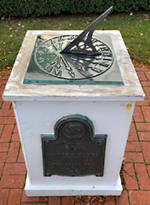 |
Mackinac |
Michigan |
USA |
Horizontal Dial |
Dial 183 |
| ca 16 in. square brass horizontal dial. Hours from 5am to 7pm in Roman numerals. Arrows radiate from the foot of the gnomon to each hour and three stars are located at the south end of the gnomon. The dial originally sat on a sightly tapered white concrete square pillar. When the dial was moved near the Jockey Club, the pedestal was redone in a square wood column painted white. A memorial plaque original on the south side of the pedestal is now on the east side. The dial was erected in memory of James R. Hayes, manager of The Grand Hotel from 1890 to 1900. The dial now sits in a small brick plaza. |
| |
| |
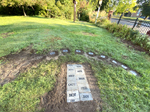 |
Northville |
Michigan |
USA |
Analemmatic |
Dial 1148 |
| This is a human (analemmatic) sundial built into a grassy landscape. At the center is the Zodiac Walkway with stone slabs labeled with the months of the year, arranged in two vertical columns from January through December. A plaque indicates the user to stand on this central walkway according to the month of the year. An ellipse of hour marks surround the walkway from 8am to 7pm. When someone stands at the center line adjacent to the month, their shadow falls across the current time of day. The hours are set for daylight saving time and corrected longitude by 34 minutes to the Eastern Time Zone, thus showing approximately 1:34 at the north point of the hour mark ellipse. |
| |
| |
 |
Oxford |
Michigan |
USA |
Armillary Sphere |
Dial 1093 |
| This is an armillary of unusual construction, mostly of nicely prepared wood. The base has three legs set out at 120°, holding horizon ring approximately 1m (39 inches) in diameter. An adjustable meridian ring for any latitude holds a brass polar axis rod and a cylinder for reading various time scales. The horizon ring has azimuths marked at every 5° and labelled every 15°. Interior to the horizon ring is the earth's celestial equator marked in right ascension in both hours and degrees. The equatorial ring ais connected to an umbrella-like portion of the north celestial pole, showing the position of the Big Dipper and Polaris. |
| |
| |
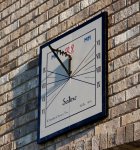 |
Saline |
Michigan |
USA |
Vertical Dial |
Dial 631 |
| A north-facing vertical dial of wood approximately 30 inches square with steel gnomon. Gnomon support includes "M M" representing 2000 millennium. Dial face includes script "RJ" for owner's initials as well as additional "M M" symbology. Hour markings show Eastern Standard Summer Time. Dial is displayed during summer months only, during which time it can be seen from the street.
Dial is on private property but can seen from a public street. |
| |
| |
 |
Traverse City |
Michigan |
USA |
Analemmatic Dial |
Dial 494 |
| This beautiful analemmatic dial was built as part of the American Society of Landscape Architects' 100 years/100 Parks project. A colored concrete pad was poured on the north/south axis and scored joints for each month. Stainless steel plates show the name of the months. On either side of the concrete pad are dry laid flagstones with creeping thyme in the joints. Hour markers are 12 inch diameter colored concrete bases with numbers cut from stainless steel. A stained glass sun plaque at the top of the month axis was made by a local artisan. Total dial size is about 10 x 20 feet. |
| |
| |
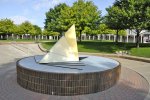 |
Warren |
Michigan |
USA |
Horizontal Dial |
Dial 269 |
| Horizontal dial 16 ft in diameter with 6 ft gnomon. The Sundial is pyramid shaped, painted in four different shades of yellow and white. Two sighting tubes along slanted upper edge. Sundial sits in center of circular concrete base with brick facing. |
| |
| |
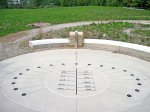 |
White Lake |
Michigan |
USA |
Analemmatic Dial |
Dial 758 |
| A 20 x 10 foot concrete analemmatic dial with Arabic numeral hour markers for 3 AM to 9 PM. A single central date line is painted on the dial face. Segmented raised seating surrounds the dial; slump stone block pillars mark the cardinal directions. A raised plaque provides dial information and directions for use. |
| |
| |
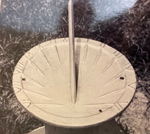 |
Ypsilanti |
Michigan |
USA |
Horizontal Dial |
Dial 1086 |
| This is the original horizontal dial and gnomon of 1909, cast in iron as a gift from the Class of 1908 (then known as the Michigan State Normal School ). This sundial was originally located on the west side of the sidewalk coming from the main south entrance of Serzer Observatory on the Eastern Michigan University campus, now the location of the EMU "Sesquicentennial Sundial". [See NASS Dial #346] This original dial is about 12 inches (30cm) with Roman hour marks from 6am to 6pm on the edge of the dial. Hour lines extend from the edge to about half way to the gnomon foot. |
| |
| |
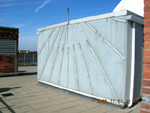 |
Ypsilanti |
Michigan |
USA |
Vertical Dial |
Dial 379 |
| A 10x15 foot vertical wall dial mounted on a stucco wall. The dial is tile with an aluminum gnomon. This dial atop Sherzer observatory has been relined and renumbered several times. The dial has a brass gnomon. The newer campus landmark is visible from as far away as Wasahtenaw Avenue. The dial was designed and built by Thad Weakley as an independent study project under professor Dr. Jon K Wooley (it earned Thad 3 credits!) |
| |
| |
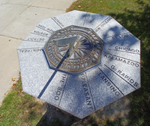 |
Ypsilanti |
Michigan |
USA |
Horizontal Dial |
Dial 346 |
| The original horizontal dial and gnomon of 1909 was cast in iron as a gift from the Class of 1908 (then known as the Michigan State Normal School ). This dial is now in the EMU archives.[See NASS Dial #1086] The current sundial was placed in the same spot in front of Serzer Observatory in the 1960's, but went missing after a broken gnomon was sent for repair, and was lost for 30 years. In 1999, during the sesquicentennial celebration of the university, EMU had the sundial restored by Arnets Becker Burrell Monuments of Ann Arbor. They also had the sesquicentennial logo added to the pedestal. The restoration was funded by the Serzer family. The elegant weathered brass and copper dial is now known as the "Sesquicentennial Sundial". Surrounding the dial are lines in the granite plinth to the cities of Montreal, Detroit, Boston, New York, Whittington DC, Toledo, New Orleans, St. Louis, Chicago, Kalamazoo, Grand Rapids, Lansing, and MT Pleasant. The original Class of 1908 4-ft (1.2m) granite pedestal still holds the sundial, including its mark of "150 years". |
| |